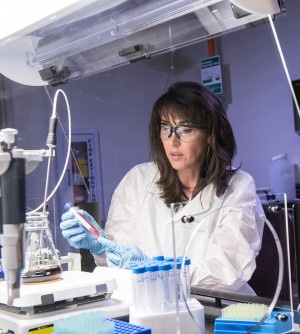Sep 16 2016
Researchers from the University of Georgia are giving new meaning to the phrase “turning rust into gold”—and making the use of gold in research settings and industrial applications far more affordable.
 Simona Murph's newest research has resulted in the creation of a new hybrid nanoparticle that combines gold and rust nanoparticles. The new substance may prove to be useful in a variety of applications including hyperthermia treatment, environmental cleaning and medical imaging. (Credit: University of Georgia)
Simona Murph's newest research has resulted in the creation of a new hybrid nanoparticle that combines gold and rust nanoparticles. The new substance may prove to be useful in a variety of applications including hyperthermia treatment, environmental cleaning and medical imaging. (Credit: University of Georgia)
The research is akin to a type of modern-day alchemy, said Simona Hunyadi Murph, adjunct professor in the UGA Franklin College of Arts and Sciences department of physics and astronomy. Researchers combine small amounts of gold nanoparticles with magnetic rust nanoparticles to create a hybrid nanostructure that retains both the properties of gold and rust.
“Medieval alchemists tried to create gold from other metals,” she said. “That’s kind of what we did with our research. It’s not real alchemy, in the medieval sense, but it is a sort of 21st century version.”
Gold has long been a valuable resource for industry, medicine, dentistry, computers, electronics and aerospace, among others, due to unique physical and chemical properties that make it inert and resistant to oxidation. But because of its high cost and limited supply, large scale projects using gold can be prohibitive. At the nanoscale, however, using a very small amount of gold is far more affordable.
In the new study published this summer in the Journal of Physical Chemistry C, the researchers used solution chemistry to reduce gold ions into a metallic gold structure using sodium citrate. In this process, if other ingredients—rust in this case—are present in the reaction pot during the transformation process, the metallic gold structures nucleate and grow on these “ingredients,” otherwise known as supports.
“We are really excited to share our new discoveries. When researchers are looking at gold as a potential material for research, we talk about how expensive gold is. For the first time ever, we’ve been able to create a new class of cheaper, highly efficient, nontoxic, magnetically reusable hybrid nanomaterials that contain a far more abundant material—rust—than the typical noble metal gold,” said Murph, who is also a principal scientist in the National Security Directorate at the Savannah River National Laboratory in Aiken, South Carolina.
When materials are broken down in size to reach nanometer scale dimensions—1 to 100 nanometers, which is approximately 100,000 times smaller than the diameter of human hair—these substances can take on new properties. For example, bulk gold does not display catalytic properties; however, at the nanoscale, gold is an efficient catalyst, accelerating chemical change for many reactions including oxidation, hydrogen production or reduction of aromatic nitro compounds.
Gold nanoparticles of different sizes and shapes display different colors when impinged by light because they absorb and scatter light at specific wavelengths, known as plasmonic resonances. These plasmonic resonances are of particular interest for biological applications. If someone shines light on the gold nanoparticles, the absorbed light can be converted to heat in the surrounding media, and if bacteria or cancerous cells are in the vicinity of such gold nanoparticles, they can be destroyed by using light of appropriate wavelength. This phenomenon is known as photothermal therapy.
By replacing some of the nano-gold with magnetic nano-rust, researchers show that the hybrid gold and rust nanostructures are able to photothermally heat the surrounding media as efficiently as pure gold nanoparticles, even with a significantly smaller concentration of gold.
“In a way, we’ve done a little better than alchemy,” said George Larsen, co-investigator and postdoctoral researcher in the Group for Innovation and Advancements in Nano-Technology Sciences at the Savannah River National Laboratory, “because these new hybrid nanoparticles not only behave better than gold in some cases, but also have magnetic functionality.”
Murph and her team looked at three different shapes of hybrid nanoparticles in this research—spheres, rings and tubes.
“A differently shaped nanoparticle means that the atoms are arranged differently—into cubes, hexagons or triangles, for example,” she said. “A different atom arrangement means different packing densities, spacing between atoms, defects, surface area and surface energies. Different shapes lead to an increased atom area that is exposed to catalyze a chemical reaction. Scientifically speaking, different shape means different crystallographic facets and surface energy that could lead to higher catalytic activity and different catalytic products.
“The results of our research showed that the ring- and tube-shaped hybrid nanoparticles proved to be better catalytic materials than the sphere-shaped nanoparticles because of the way the atoms are arranged in the structure at this nanoscale. More importantly, the hybrid nanoparticles of gold and rust are better catalysts than gold nanoparticles alone, even with a significantly smaller amount of gold.
When these different shaped hybrid nanoparticles were exposed to light of specific wavelength, the spheres heated the solution up to slightly higher temperatures than the ring- or tube-shaped nanoparticles.
“This could have a variety of biological applications such as tracking, drug delivery or imaging inside the body,” Murph said. “If you feed these gold nanoparticles to bacteria and shine the light on them, you could destroy these by just using light.”
The hybrid structures could also be used for new application, such as sensing, hyperthermia treatment, environmental cleaning and protection medical imaging applications including magnetic resonance imaging contrast agents, product detection and manipulation.
The research study, “Multifunctional Hybrid Fe2O3-Au Nanoparticles for Efficient Plasmonic Heating,” is available at http://www.jove.com/video/53598/multifunctional-hybrid-fe2o3-au-nanoparticles-for-efficient-plasmonic.
The study was supported by Department of Energy Laboratory Directed Research & Development Strategic Initiative Program of the Savannah River National Laboratory.
Additional co-investigators on this study were Robert Lascola and Will Farr of the Savannah River National Laboratory.